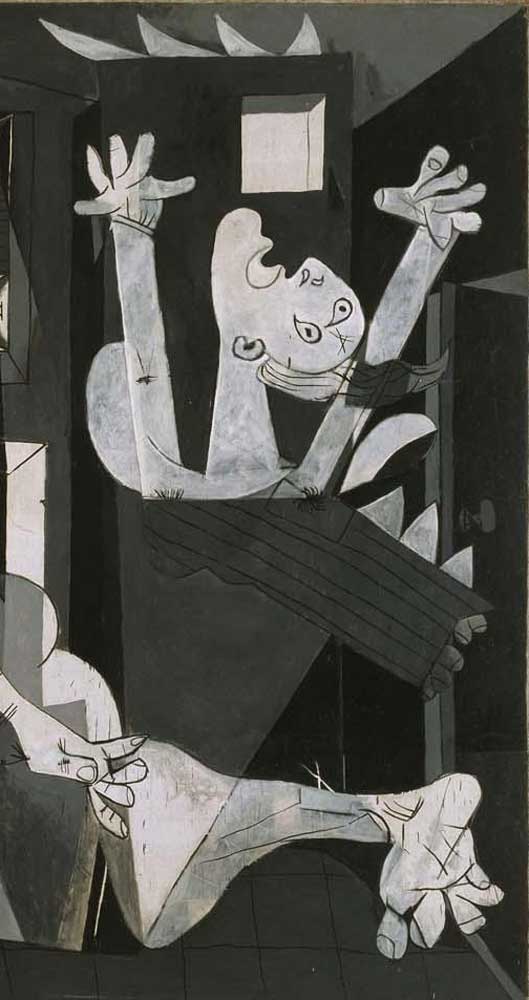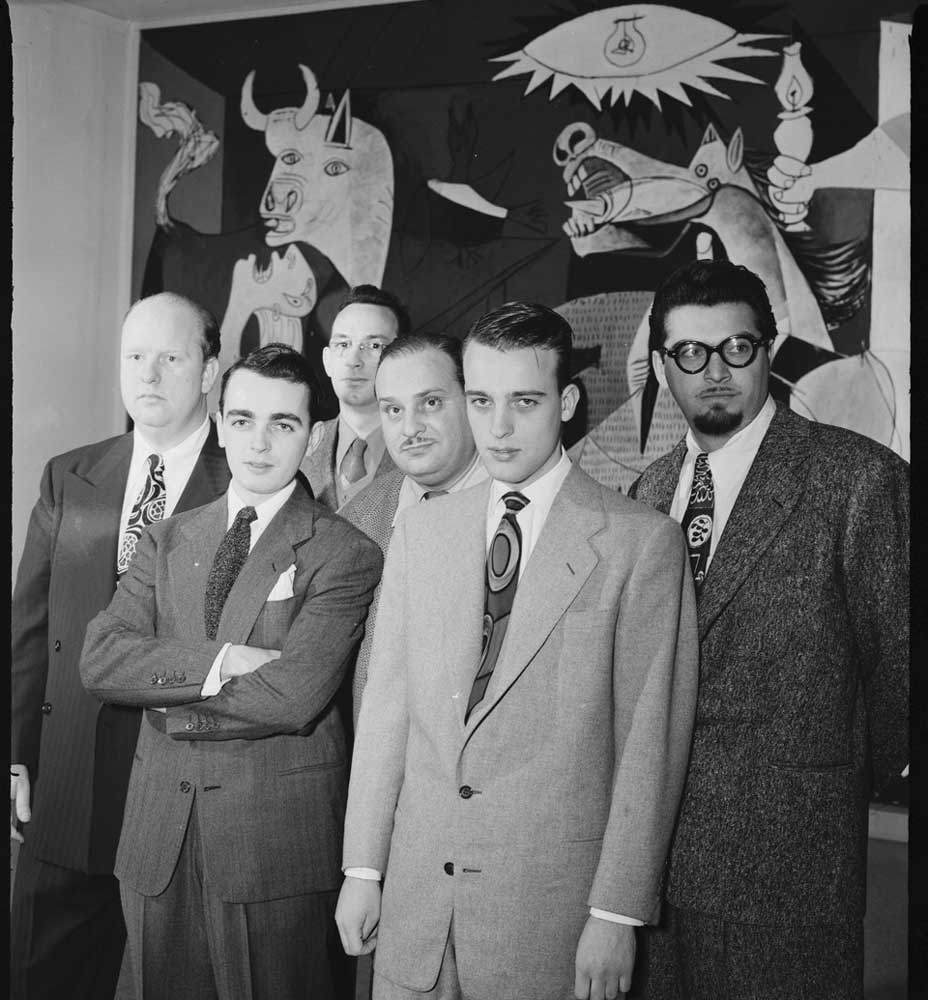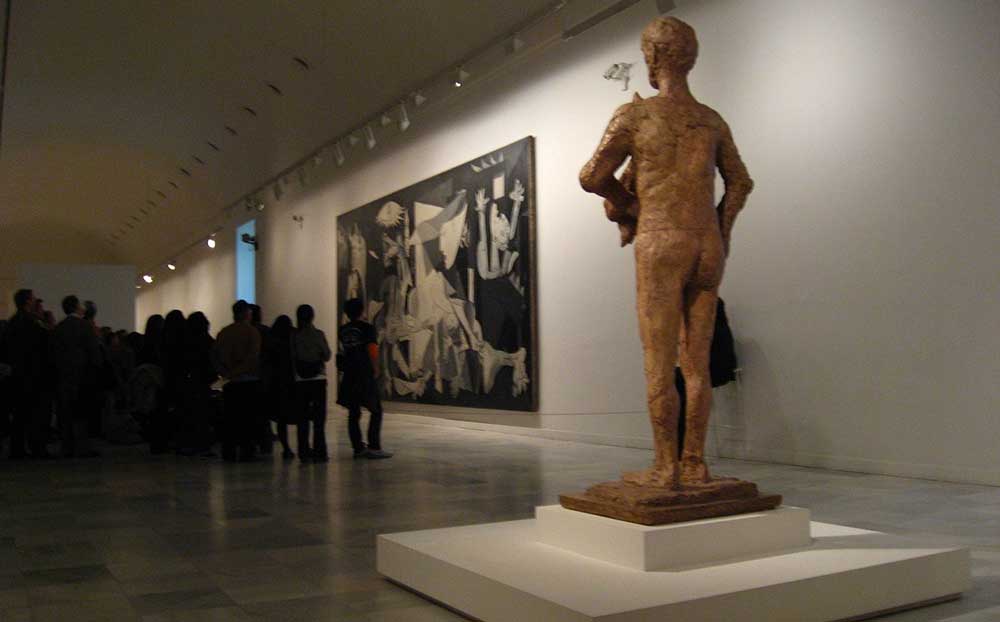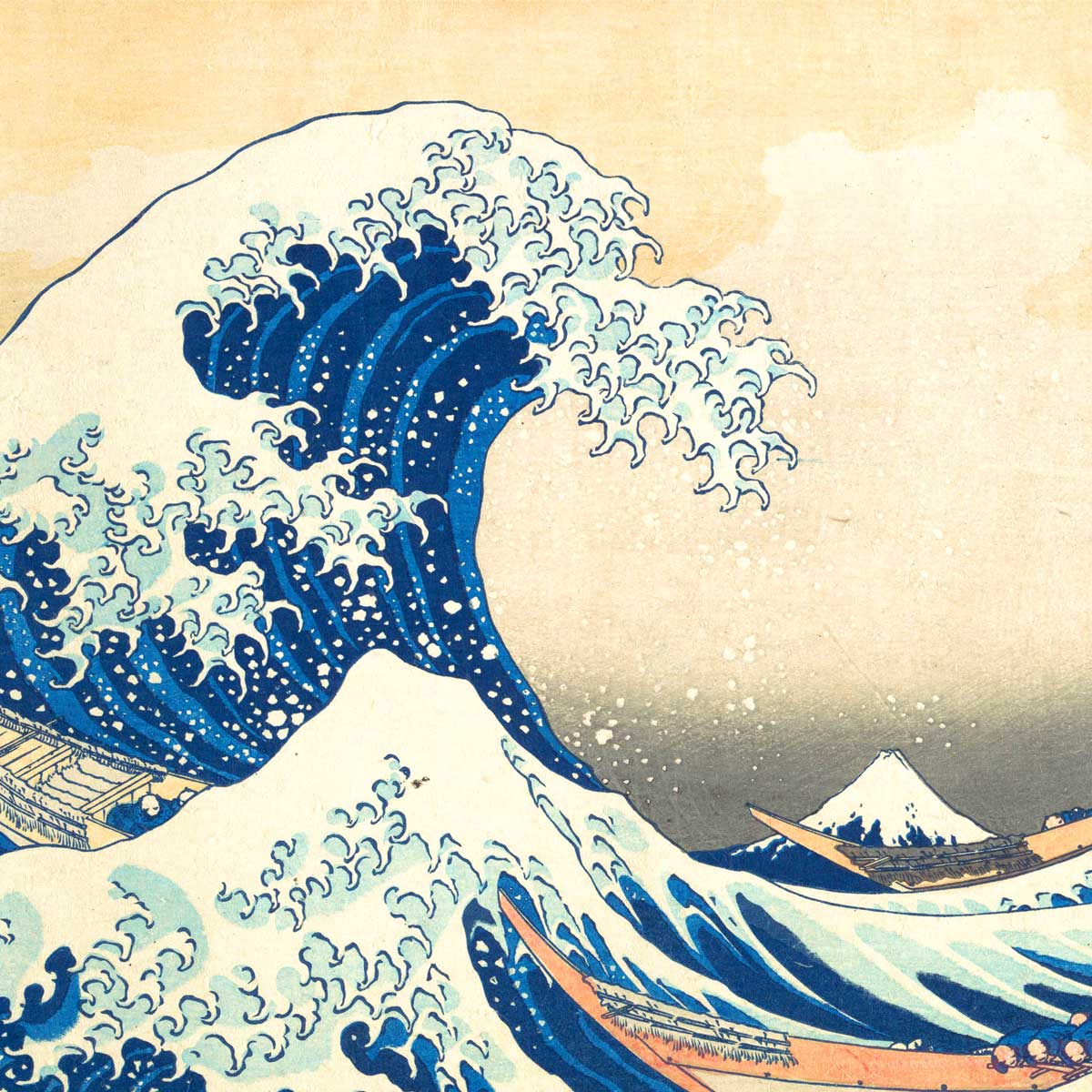Guernica is undoubtedly one of the most recognized works of art by the painter Pablo Picasso, considered by many art critics as the most moving and powerful anti-war painting in history.
In this article we are going to tell you all the details and secrets about this impressive work of art
who commissioned the painting “El Guernica”?

In January 1937, while Pablo Picasso was living in Paris, in Rue des Grands Augustins, the Spanish Republican government commissioned him to create a large mural for the Spanish pavilion at the 1937 Paris Universal Exposition. This work was to contribute to raising awareness of the war and to raising the necessary funds. Picasso, who had last visited Spain in 1934 and would never return, was the Honorary Director in Exile of the Prado Museum.
From January until the end of April, Picasso worked somewhat dispassionately on the first sketches of the project, which depicted his eternal theme of an artist’s studio. A few days later, on May 1, Picasso read the account of George Steer about the bombing, which had originally been published in The Times and The New York Times on April 28, and abandoned his initial idea. Following Larrea’s suggestion, Picasso began sketching a series of preliminary drawings for Guernica.
Historical Context of Guernica

During the Spanish Civil War, the Republican forces were made up of varied factions, including communists, socialists, anarchists, and others with different objectives. However, they were united in their opposition to the nationalists, led by General Francisco Franco, who sought a return to pre-republican Spain based on law, order and traditional Catholic values.
Guernica, a town in the province of Vizcaya in the Basque Country, was considered the northern bastion of the Republican resistance movement and the center of Basque culture. Around 4:30 p.m. on Monday, April 26, 1937, Nazi Germany’s Condor Legion warplanes, under the command of Colonel Wolfram von Richthofen, bombed Guernica for about two hours. In his diary of April 30, 1937, von Richthofen wrote
When the first squadron of Junkers arrived, there was already smoke everywhere (from the VB [VB/88] which had attacked with 3 planes); no one identified the targets on the roads, the bridge and the suburb, so they simply threw everything towards the center. The 250 knocked down several houses and destroyed water pipes. The arsonists could now spread out and be effective. The materials of the houses: shingle roofs, wooden porches and timber framing, caused total annihilation. Most of the inhabitants were away on vacation; most of the rest left town immediately at the start [of the bombing]. A small number perished in the shelters that were hit.”
Other accounts state that, it being market day in Guernica, its inhabitants congregated in the center of the town. When the bombing began, they could not escape because the roads were full of debris and the bridges leading out of the town had been destroyed.
Guernica was a quiet town 10 kilometers from the front lines, and between the front lines and Bilbao, the capital of Bizkaia (Biscay). But any Republican retreat towards Bilbao, or any Nationalist advance towards Bilbao, had to pass through Guernica.
Wolfram von Richthofen ‘s war diary entry of April 26, 1937 reads, “K/88 [the Condor Legion bomber force] was targeting Guernica to stop and disrupt the Red retreat which has to pass through here.” According to the German concept of tactical bombing, areas that were transport and troop movement routes were considered legitimate military targets. The next day, Richthofen wrote in his war diary,“Guernica burning.”
The nearest military target of importance was a war products factory on the outskirts of Guernica, but it was unscathed by the attack. As such, the attack was widely condemned as a terrorist bombing….
Since most of the men of Guernica were away fighting on behalf of the Republicans, at the time of the bombing the town was populated mostly by women and children. As Rudolf Arnheim writes, for Picasso:“Women and children make Guernica the image of innocent and helpless victimized humanity. Moreover, women and children have often been presented by Picasso as the very perfection of humanity. In Picasso’s view, the attack on women and children goes to the very core of humanity.”
Times journalist George Steer, a Basque sympathizer and Republican, pushed this event onto the international stage and brought it to the attention of Pablo Picasso. Steer’s testimony was published on April 28 in The Times and The New York Times, and on the 29th it appeared in L’Humanité, a French communist newspaper. Steer wrote:
Guernica, the oldest town of the Basques and the center of their cultural tradition, was completely destroyed yesterday afternoon by insurgent aircraft. The bombardment of this open town far from the lines occupied exactly three hours and a quarter, during which time a powerful fleet of planes consisting of three types of German bombers, Junkers and Heinkel, did not cease to unload on the town bombs weighing 1,000 pounds and upwards and, it is estimated, more than 3,000 two-pound aluminum incendiary shells. The fighters, for their part, swooped down from the center of the city to strafe the civilian population that had taken refuge in the camps.”
Picasso lived in Paris during the German occupation in World War II. An oft-repeated anecdote is that a German officer once asked him, upon seeing a photo of Guernica in Picasso’s apartment, “Did you do that?” and Picasso replied, “No, you did it.”
Characteristics of the painting. Materials and Composition

Guernica was painted with a matte paint specially formulated at Picasso’s request to have as little gloss as possible
The canvas was 3.49 meters high and 7.76 meters wide,
American artist John Ferren helped him prepare the monumental canvas, and photographer Dora Maar, who had been working with Picasso since mid-1936 photographing his studio and teaching him the technique of camera-less photography, documented his creation.
Aside from their documentary and advertising value, Maar’s photographs “helped Picasso dispense with color and give the work the black-and-white immediacy of a photograph,” according to art historian John Richardson.
Picasso, who rarely allowed strangers into his studio to watch him work, admitted influential visitors to observe his progress on Guernica, believing the publicity would help the anti-fascist cause:
“The Spanish struggle is the struggle of reaction against the people, against freedom. My whole life as an artist has been nothing but a continuous struggle against reaction and the death of art. How could anyone think for a moment that I could agree with reaction and death? In the panel I am working on, which I will call Guernica, and in all my recent works of art, I clearly express my abhorrence of the military caste that has plunged Spain into an ocean of pain and death.”
Picasso worked on the painting for 35 days and finished it on June 4, 1937.
Elements of Guernica

The scene takes place inside a room in which, on the left, a large-eyed bull with a tail suggesting the outflow of smoke stands over a grieving woman holding a dead child in her arms

A horse falls in agony in the center of the room, with a large hole in its side, as if it had just been pierced by a spear or javelin. The horse appears to be wearing chainmail armor, decorated with vertical markings arranged in rows.

A dead and dismembered soldier lies beneath the horse. The hand of his severed right arm holds a shattered sword, from which a flower grows, and the open palm of his left hand contains a stigma, a symbol of martyrdom derived from the stigmata of Christ. Above the head of the suffering horse shines a naked bulb in the shape of an all-seeing eye.

At the upper right of the horse, the head and outstretched right arm of a frightened female figure appears to have floated into the room through a window, and is witness to the scene. In her right hand she carries a lighted lamp, and holds it near the bare bulb. From the right, below the witness, an astonished woman staggers toward the center, staring at the lit bulb with a blank stare.
Daggers suggesting screams have replaced the tongues of the horse, the bull and the distressed woman. To the right of the bull appears a dove on a cracked wall through which light from outside shines.

On the far right, a fourth woman, her arms raised in terror, her mouth open and her head thrown back, like that of the afflicted woman, is caught in the fire above and below. Her right hand suggests the shape of an airplane.
A dark wall with an open door defines the right side of the room.
Two “hidden” images formed by the horse appear in Guernica:
- The nostrils and upper teeth of the horse can also be seen as a human skull facing left and slightly downward.
- A bull appears to gore the horse from below. The bull’s head is mainly formed by the entire foreleg of the horse that has the knee on the ground. The kneecap of the leg forms the nose of the head. A horn appears on the chest of the horse. The tail of the bull forms the image of a flame from which smoke is rising, which seems to appear in a window created by the lighter gray tone surrounding it.
Symbolism and interpretation of Guernica

Interpretations of Guernica vary widely and contradict each other. This extends, for example, to the two dominant elements of the mural: the bull and the horse. Art historian Patricia Failing states, “The bull and the horse are important characters in Spanish culture. Picasso himself undoubtedly used these characters to play many different roles over time. This has made the task of interpreting the specific meaning of the bull and the horse very difficult. Their relationship is a kind of ballet that was conceived in various ways throughout Picasso’s career.”
When asked to explain the elements of Guernica, Picasso said
…this bull is a bull and this horse is a horse… If you give a meaning to certain things in my paintings it may be quite true, but it is not my idea to give that meaning. The ideas and conclusions that you have drawn I have drawn them too, but instinctively, unconsciously. I do the painting for the painting. I paint the objects for what they are.
In Franco’s Dream and Lie, a series of narrative sketches that Picasso also created for the Universal Exposition, Franco is depicted as a monster who first devours his own horse and later confronts an enraged bull. Work on these illustrations began before the bombing of Guernica, and four additional panels were added, three of which relate directly to the Guernica mural.
According to scholar Beverly Ray, the following list of interpretations reflects the general consensus of historians: “the shape and posture of the bodies express protest”; “Picasso uses black, white and gray paint to create a somber mood and express pain and chaos”; “the burning buildings and crumbling walls not only express the destruction of Guernica, but reflect the destructive power of the civil war.”“the newspaper print used in the painting reflects how Picasso learned of the massacre“; “the light bulb in the painting represents the sun”; and“the broken sword near the bottom of the painting symbolizes the defeat of the people at the hands of their executioners.”
Alejandro Escalona said:
“The chaos that unfolds seems to occur in enclosed places provoking an intense sense of oppression. There is no way out of the nightmarish urban landscape. The absence of color makes the violent scene unfolding before your eyes even more horrifying. The blacks, whites and grays startle you, especially since you’re used to seeing the images of war beamed live and in high definition right into your living room.”
Drawing attention to a series of preliminary studies, the so-called primary project, which show a workshop installation incorporating the central triangular shape that reappears in the final version of Guernica, Becht-Jördens and Wehmeier interpret the painting as a self-referential composition in the tradition of workshop paintings such as Diego Velázquez’s Las Meninas
In his work, Picasso seems to be trying to define his role and power as an artist in the face of political power and violence. But far from being a mere political painting, Guernica should be seen as Picasso’s commentary on what art can actually contribute to the self-affirmation that liberates every human being and protects the individual against overwhelming forces such as political crime, war and death
Which museum is Guernica in? A brief history

At Picasso’s request, the custody of Guernica was entrusted to the Museum of Modern Art, and it was his express wish that the painting not be delivered to Spain until freedom and democracy had been established in the country.
Between 1939 and 1952, Guernica traveled extensively in the United States. Between 1941 and 1942 it was exhibited twice at the Fogg Museum at Harvard University.
Between 1953 and 1956 it was exhibited in Brazil, then in the first Picasso retrospective in Milan, Italy, and then in many other major European cities before returning to MoMA for a retrospective celebrating Picasso’s 75th birthday. It then went to Chicago and Philadelphia. By then, concern about the painting’s condition led to the decision to keep it in one place: a room on MoMA’s third floor, where it was accompanied by several preliminary studies by Picasso and some photographs by Dora Maar of the work in progress. The studies and photos were often loaned for other exhibitions, but until 1981, Guernica remained at MoMA.
During the Vietnam War, the room containing the painting became the site of occasional anti-war vigils. These were usually peaceful and uneventful, but on February 28, 1974, Tony Shafrazi – allegedly protesting the habeas corpus petition of Second Lieutenant William Calley following his indictment and conviction for the murder of 109 Vietnamese civilians during the My Lai massacre – spray-painted the painting with red spray paint, with the words “KILL LIES ALL.” The paint was relatively easily removed from the varnished surface.
As early as 1968, Franco had expressed interest in Guernica coming to Spain, but Picasso refused until the Spanish people once again enjoyed a republic. He later added other conditions, such as the reestablishment of “public liberties and democratic institutions”
Picasso died in 1973. Franco, ten years younger than Picasso, died two years later, in 1975. After Franco’s death, Spain became a democratic constitutional monarchy, ratified by a new constitution in 1978. However, MoMA was reluctant to relinquish one of its greatest treasures, arguing that a monarchy did not represent the republic that had been stipulated in Picasso’s will as a condition for the painting’s handover. Under great pressure from various observers, MoMA finally ceded the painting to Spain in 1981. Spanish historian Javier Tusell was one of the negotiators.
Upon its arrival in Spain in September 1981, it was exhibited for the first time behind bombproof and bulletproof glass screens at the Casón del Buen Retiro in Madrid for the centennial celebration of Picasso’s birth on October 25.
The exhibition was visited by nearly a million people in the first year. Since then there have been no attempts at vandalism or any other threat to the painting’s security.

In 1992, the painting was moved from the Prado Museum to a purpose-built gallery at the Museo Nacional Centro de Arte Reina Sofía, both in Madrid, along with some two dozen preparatory works
This action was controversial in Spain, as Picasso’s will stated that the painting was to be exhibited at the Prado. However, the move was part of a transfer of all of the Prado’s post-early 19th-century art collections to other nearby buildings in the city for reasons of space; the Reina Sofía, which houses the capital’s national collection of 20th-century art, was the natural place to move it to. At the Reina Sofia, the painting has more or less the same protection as any other work.
Basque nationalists have advocated that the painting be taken to the Basque Country, especially after the construction of the Guggenheim Museum Bilbao. Those in charge of the Reina Sofia claim that the canvas is considered too fragile to be moved. Even the Guggenheim staff does not see a permanent transfer of the painting as possible, although the Basque government continues to support the possibility of a temporary exhibition in Bilbao.




